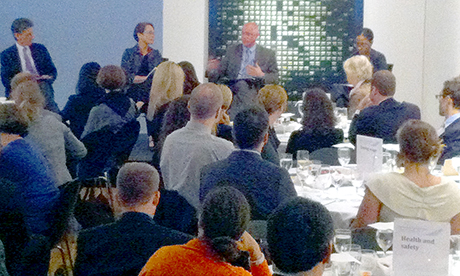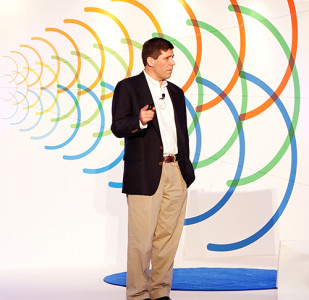HBS Cases: Women MBAs at Harvard Business School
Professor Boris Groysberg discusses his new case, "Women MBAs at Harvard Business School: 1962-2012," which delves into the experiences of the School's alumnae over the past 50 years.
In 1962, the Harvard Business School faculty voted for women to be directly admitted to the two-year MBA Program for the first time. In September 1963, eight female students enrolled in the Class of 1965, alongside 676 men. The School has come a long way toward gender equity since then, with women making up 40 percent of the Class of 2014. But a new case study shows that there's still a ways to go.
“WE WANT THEM TO GRAPPLE WITH WHAT IT TAKES TO BUILD AN ORGANIZATION, TO LEVERAGE DIVERSITY AND CREATE AN INCLUSIVE CULTURE.” —BORIS GROYSBERG
Titled "Women MBAs at Harvard Business School: 1962-2012," the case delves into the experiences of alumnae and alumni over the past 50 years, both inside and outside the classroom, as Dean Nitin Nohria considers what HBS might be like 10 years from now, when his young daughters are grown.
"It looks back and asks whether we have been successful," says Boris Groysberg, the Richard B. Chapman Professor of Business Administration at HBS, who cowrote the case with HBS Global Research Group associate director Kerry Herman and research associate Annelena Lobb. "It also lets us look into the future and ask, how can we create a more inclusive culture? And how should HBS change over the next 10 years in order to accelerate the advancement of women leaders who make a difference in the world?"
On March 8, in observance of International Women's Day, faculty members will teach the case to all first-year MBA students at HBS (Nohria will introduce it to second-year students), in conjunction with a multimedia video case comprising oral histories of HBS alumnae and female professors. Second-year students and some Executive Education participants will have the option of discussing the case that day, too. In April, the case will be taught to 700 alumnae and alumni at the W50 Summit, the centerpiece of the 50th anniversary celebration.
EVENTS
Women's 50th
This article is part of a continuing series on faculty research and teaching commemorating the 50th anniversary of the first women to enter Harvard Business School's two-year MBA program.
"We want them to grapple with what it takes to build an organization, to leverage diversity and create an inclusive culture," Groysberg says. While "Women MBAs at Harvard Business School" commemorates the 50th anniversary of women in the full two-year MBA Program, the authors made sure that it was more candid than congratulatory. "The Dean made it clear early on that what really happened here is what should be in the case, because one way to make the future of this institution better is to talk honestly about our past. So there are good stories, and there are stories that the School probably isn't very proud of. But it's all part of our history, and hopefully our future is going to be better than our past."
"YOU'RE A SHINING LIGHT"
The authors conducted some 60 interviews for the case, and indeed the anecdotes in the case run the gamut from inspiring to unsettling. One of the seven women in the Class of 1967 recalls a supportive group of male classmates, one of whom told her, "You're a shining light, and we want you to know how much we appreciate you." But another woman in the same class recalls male classmates repeatedly asking her, "Tell me why you're here at HBS taking a place away from a man."
HBS professors' attitudes toward women were a mixed bag, too. As early as the 1940s and into the 1960s, several HBS faculty members would cross the Charles River to teach business administration courses to students at Radcliffe College, indicating a personal commitment to educating women well before they were officially admitted into the full two-year MBA Program. In 1965, the School hired an administrative assistant to the Dean, whose main responsibility was to recruit women and make sure they received moral support during their time at HBS. Many professors joined the charge, actively encouraging women to apply to HBS.
But others were uncomfortable with women in the classroom. A 1971 alumna remembers several professors who never called on a woman in class "unless it was a discussion of a woman's product." A Class of 1973 alumna recalls professors "who, in the middle of a class, would look at the women and the African Americans and say, 'Is this too difficult for you?'"
By 1985 women made up 25 percent of the graduating MBA class and Professor Regina Herzlinger (DBA 1971) was becoming the first female faculty member to receive an endowed chair at HBS. Still, anecdotes reveal an ongoing "obliviousness" on the part of the administration. A 1982 alumna says, "We still had urinals in the women's restrooms almost 20 years after women had been admitted. So it was pretty clear that Harvard hadn't quite embraced women at that time."
The 1990s proved frustrating for those working toward gender equality at HBS. In 1995, women made up only 28 percent of the MBA class—the lowest percentage since the mid-1980s. That said, the School was making strides in research on gender issues. Myra M. Hart (MBA '81, DBA '95) joined the faculty in 1995, for example, and initiated an executive program for women, which was based on her doctoral research on the career choices of female HBS grads.
“WE STILL HAD URINALS IN THE WOMEN’S RESTROOMS ALMOST 20 YEARS AFTER WOMEN HAD BEEN ADMITTED.” —MBA CLASS OF 1982 ALUMNA
By the middle of the next decade, 38 percent of entering students in the MBA Program were women. Many of the alumna reported having felt more comfortable at HBS—encouraged to speak up in class, for example—than in previous decades.
Kathleen L. McGinn, the Cahners-Rabb Professor of Business Administration, established a set of field studies in which female second-years researched the reasons behind differing academic performances between male and female students. Robin J. Ely, the Diane Doerge Wilson Professor of Business Administration and, since 2010, Senior Associate Dean for the School's Culture and Community Initiative, organized a research team to look into the factors that made female students and faculty thrive. By 2012, men and women were performing equally in terms of grades, and they generally reported equal levels of student satisfaction.
Recent alumnae, however, note a dearth of female protagonists in the cases discussed in class. ("I think I remember two," said a 2011 alumna.) Even now, only about 8 percent of HBS cases focus on a woman protagonist. "I think we can certainly do better," Groysberg says. "The argument in the 1970s was that we just didn't have enough examples of female protagonists in business. I don't think that's a valid argument in 2013."
Descriptions of life after HBS in the case reveal a stubborn consistency from 1962 to 2012: the fact that women seem to bear the brunt of the work/family trade-off decisions. And classroom discussions indicate that students just assume that's the way it goes. In the case, Nohria recalls his experience teaching the first-year required leadership course: "When there were women protagonists in a case, people had questions about how they managed work-family balance. Men had families, too, but we didn't seem to ask those questions about men."
AN EMOTIONAL EXPERIENCE
Discussing the case in his office recently, surrounded by precarious stacks of documents, Groysberg looks a little weary. "For me this has been a very emotional experience, this case," he says. "There were maybe 100 hours of interviews. We interviewed in teams, and many times we'd walk out together just speechless after hearing these stories. Sometimes I'd get home and not fall asleep until three or four o'clock in the morning, just thinking about it and unwinding."
But he's hopeful and excited about the School's role in the future of women in business. "I really think we are at an inflection point in 2013," he says. "At an individual level, at an organizational level, and even at a governmental level, more women and men are tired of gender inequality. It's our opportunity to make something of that—or it's our opportunity to miss."
In addition to teaching students about building an inclusive organization, the case will give faculty an opportunity to collect—and maybe employ—students' ideas about how to make HBS a more inclusive place.
"I'm anticipating a co-creation of knowledge and a co-creation of ideas," Groysberg says. "Our students have aspirations for the School, and so do our alumni. There's a reason they picked HBS over other schools. It's going to be a learning experience for us as much as it is a learning experience for the students in the classroom."































